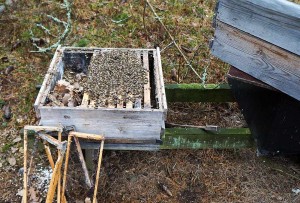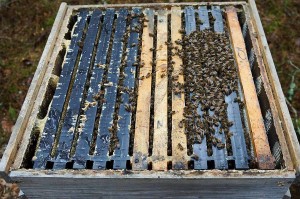 The bottom box with the cozy home of the mouse. To the right the two upper boxes full of bees, waiting for return on top of the bottom one.
The bottom box with the cozy home of the mouse. To the right the two upper boxes full of bees, waiting for return on top of the bottom one.
You know there is a front and a back, and up and down, and sideways, on combs and foundation. Ever seen the Y at the bottom of the cells? The side of the comb with upside down Y:s is said to appear towards the middle of the bee cluster, when the bees build their own home of combs. When Y is facing up, or down, the cells have tips pointing upwards and downwards. Are tips pointing sideways (and not parallel sides sideways) Y at the cell bottoms (hold the comb or foundation against the light and it’s easier to see) is facing right or left. Such combs is said to appear sometimes in the middle of the cluster of naturally drawn combs.
To place combsides with Y pointing downwards towards the middle of the box (easiest marking new combs with foundation on the toplist) is said to be beneficial for the bees – where they sit in the box, development, harmony, etc. Anyway I couldn’t figure out that it could be possible to be negative for the bees. So I started to mark new combs last year and had the intention to test natural positioning. But it turned out I seldom put on a whole box of foundation. I did though on one hive, almost. And it happened to be mostly plastic frames with plastic foundation from Mann Lake, with cell size slightly bigger than 4.9 mm. I tested Mann Lake’s standard plastic frames and foundation last year too. And this hive turned out to be the one receiving highest number of plastic frames for testing.
So this hive became a testhive for both plastic frames and natural positioning. A bad test actually. Just using one colony and for two parameters. Anyway, had the colony died or dwindeled or turned out to develop weird in any way it had pointed to negative effects for at least one of the tested two parameters.
At best one could say now that it would be interesting to continue the tests, with both parameters. Because the outcome seems to be positive. It turned out to be a hard test concerning overwintering. Not though because of hard weather. The winter before (2012-13) was colder and longer and the colony came out weaker from winter than this spring 2014. 2012 it was treated against Varroa with 10 grams of thymol in total and nothing else (two pieces of dish cloth with 5 grams each).
The colony came out of winter in a weaker state 2013 so the bottom box was culled and a new third box for brood was added when it was time for that (12 frames of shallow size, 448 x 137 mm). This box mostly consisted of plastic frames and foundation, but with a few drawn combs in the middle of the box. And the sides of the combs with Y facing downwards was pointing inwards to the middle of the box. Honey production was average 2013. 2013 the colony was treated with only 5 grams of thymol, with the same queen, half the amount compared to 2012. (Now this amount of thymol is low compared to recommended amounts for bees in general, at least 10 times more would be normal.)
The colony was wintered on three shallow boxes (12 frames) full of bees with 25 kg of honey (>50 pounds) and 10 kg of sugar (>20 pounds). It came out of winter (March 1) as strong as it went into it and heavy of food. Though I had forgotten to put on the entrance reducer so that a mouse had made it comfortable for itself as its winter house, both warm and food nearby, cozy. The bees hadn’t had their cleansing flight yet, confined to the hive since middle of November. The cleansing day came March 9.
After cleaning the bottom box from eaten empty frames and the cozy remnants of the mouse March 1 I returned two weeks later and the colony was happy, and no bee droppings on the front of the hive, still full of bees out to the sides also in the top box. With so much honey in the stores for long winters like ours it’s not unusual with bee droppings on the front of the hive.
So what’s the cause of the good standard of the colony this spring:
- the mild winter,
- natural positioning in the upper third box, or
- the plastic frames in the upper third box
- – maybe all three of these parameters?
